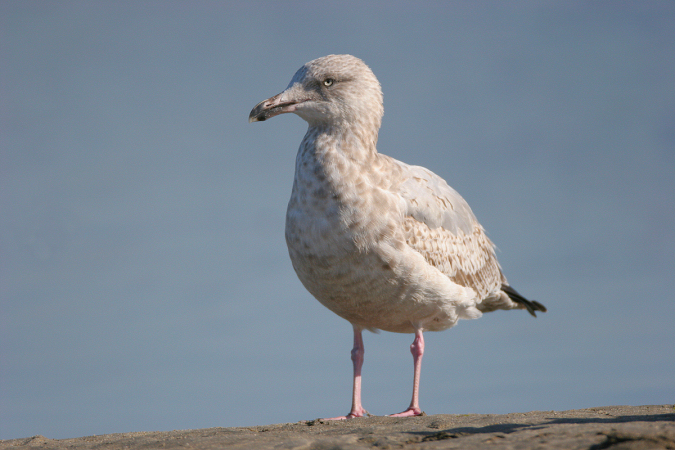
Location: San Diego Bay (J Street), Chula Vista, CA
Date: 2006-12-28
Lens: Canon 600mm IS F4 + 1.4x II Converter

 Herring Gull
Larus argentatus
Herring Gull
Larus argentatus
 Description
DescriptionDespite its name, the Herring Gull actually feeds on nearly anything, including fish, shrimp, prawns, crabs, small mammals and birds, eggs, grain, carrion and human produced garbage. While at sea, the Herring Gull forages in large, loose groups. We are lucky the bird is still around today. Heavy collecting of Herring Gull eggs and feathers during the nineteenth century nearly eliminated the bird from North America.
General: Sexes similar. 20 inches in length.
Adult Alternate: White head, neck, breast, belly, tertial crescent, and tail. Gray back and upperwings. Bright yellow bill with red spot near tip of lower mandible. Yellow eye. Pink legs. Black primaries with white tips.
Adult Basic: Similar to adult alternate, but with blurry brown streaking and spotting on head and nape.
First-Year Juvenile: Brown body plumage. Black bill. Dark brown primaries and secondaries. Dark, barred rump. Dark tail. Dark to pinkish legs.
Second-Year Juvenile: Pale brown head, neck, upper breast, and belly. Pinkish bill with black tip. Grayish back. Dull brown upperwing coverts. Dark brown primaries. White tail with black terminal band.
Third-Year Juvenile: Similar to adult basic, but often lacks adult bill and wing pattern. It also often retains a partial tail band.
Forages and winters at sea, along beaches, mudflats, dumps, and other areas where human-produced food is available. Breeds on islands across Alaska, northern Candada, and northeast United States.
 Nesting
Nesting3 lignt olive eggs with dark brown speckles. The eggs have a 24-28 day incubation period. Fledging occurs in 35 days. The nest is a scrape in sand or dirt, sometimes lined with feathers, vegetation or plastic.